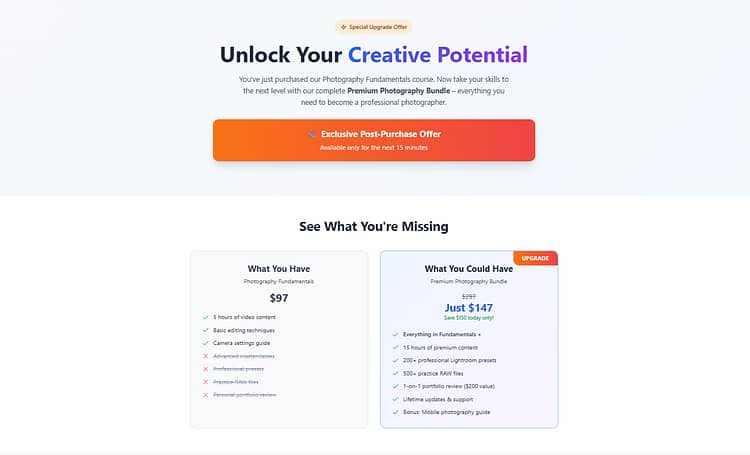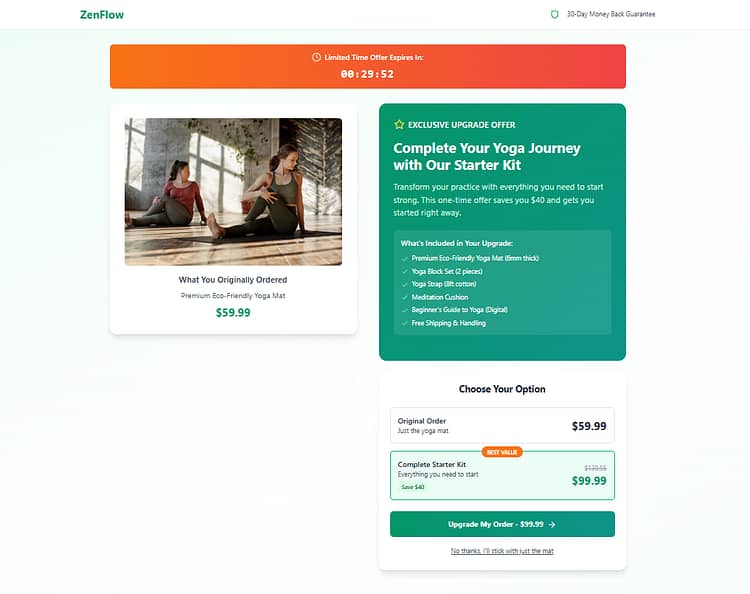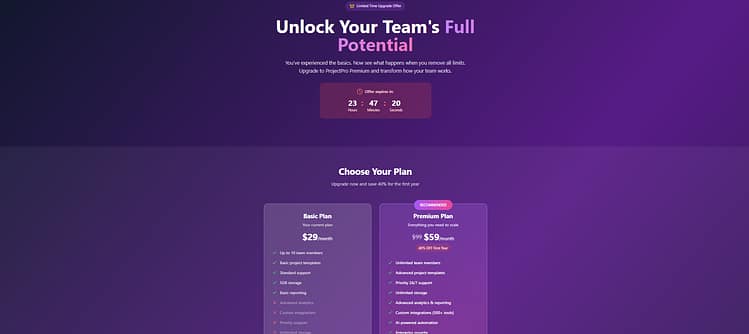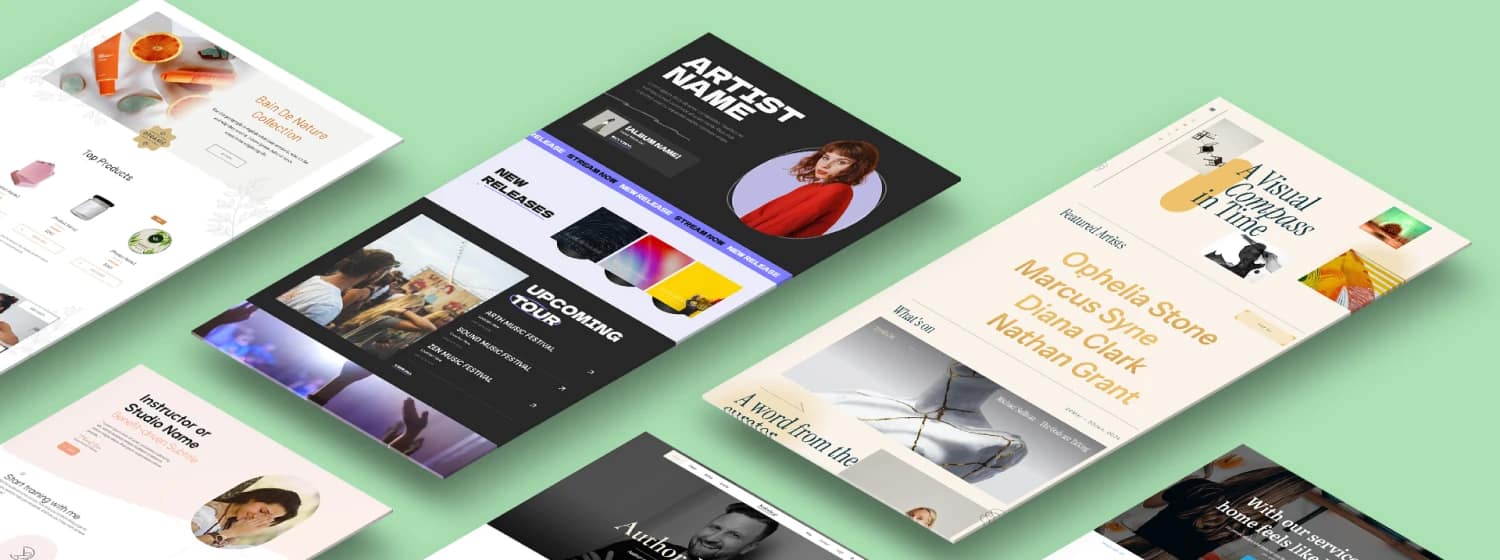TL;DR: Upsell Strategy That Actually Moves the Needle
A strong upsell strategy isn’t about squeezing more revenue — it’s about guiding your customer toward a better outcome right after purchase. Here’s how to do it right:
- Make it relevant The offer should be a natural next step — not a detour.
- Focus on outcomes Show how the upsell improves results, saves time, or removes friction.
- Remove barriers One click. No extra forms. No repeated payment steps.
- Use visual contrast Before vs. after, basic vs. upgrade — help them see the difference fast.
- Keep it focused One offer. One benefit. One decision.
- Don’t fake urgency If the deadline isn’t real, don’t use it. It costs you trust.
- Test and adjust Track what works. Test layout, copy, and timing to improve performance.
👉 Quick gut check: If your upsell feels like a helpful next step — not a push — you’re doing it right.
This is Why Post-Purchase Upsells Deserve More Attention
You did it! You made the sale!
BUT if that’s where the journey ends, you’re leaving serious revenue (and relationship equity) on the table.
For most businesses, post-purchase is the most ignored part of the funnel — which is wild, because it’s where customers are most ready to say yes again.
This is your chance to get more out of every sale.
Not by pushing harder — but by offering something smarter. Something that builds on what they just bought, helps them get even better results, and makes them feel like they made the right decision.
In this guide, I’ll show you how to create post-purchase upsell offers that are simple, ethical, and wildly effective — powered by sharp messaging, conversion-focused design, and tools that make execution seamless.
Most Asked Questions About Upsell Strategies for Online Businesses
If you’ve ever tried to implement an upsell and ended up with a confused customer, low conversion rate, or just a general “meh” feeling — you’re not alone.
Upselling has the potential to dramatically increase your average order value and customer lifetime value, but only when it’s done with strategy, timing, and empathy. So before we dive into the tactics, let’s tackle the questions that come up most often:
Upselling means offering an upgrade or add-on that improves the customer’s result. It increases revenue, boosts retention, and strengthens customer loyalty.
The best upsells are timely, relevant, and clearly valuable. One-click offers, feature unlocks, fast-track options, and bundles work well when placed after purchase.
Upselling offers a better version of what was just bought. Cross-selling adds a complementary product. Use upsells when you want to improve the original result, and cross-sells when the add-on supports the main product.
Use purchase behavior, timing, and product history. Look for customers who’ve shown interest, completed key steps, or reached a milestone.
Irrelevant offers, poor timing, unclear value, too many choices, and price jumps that feel unjustified. These all reduce trust and conversions.
Tailored upsells based on user data convert better. Use behavior triggers, segmentation, and first-party data to match offers with the right person.
Bundling adds perceived value. Tiered pricing gives customers clear upgrade paths. Both make upsells easier to justify and more attractive.
You need a solid page builder, email automation, and CRM integration. Thrive Suite includes tools like Thrive Architect and Thrive Optimize to manage all of this directly inside WordPress.
Track key metrics like average order value (AOV), conversion rate, attach rate, and lifetime value (LTV). Use this data to refine your offer placement and copy.
Quick Definitions: Upsell vs. Cross-Sell vs. Downsell
Before we go further, let’s clear up three terms that often get lumped together — but play very different roles in your funnel:
Upsell
“Would you like to upgrade to the premium version?”
An upsell encourages the customer to buy a higher-tier, more feature-rich version of what they’re already considering. Think: more storage, faster results, additional support — a better version of the same product.
🟢 Use case: Upgrading from a basic online course to a VIP bundle with coaching and templates.
---
Cross-sell
“Would you like to add this related product?”
A cross-sell offers a complementary product that pairs well with the original purchase. It’s not an upgrade — it’s an add-on.
🟢 Use case: Buying a tripod after purchasing a camera.
---
Downsell
“Not ready to commit? Here’s a lighter option.”
A downsell offers a lower-priced alternative when a customer declines your original offer. It’s a smart way to catch people before they walk away completely.
🟢 Use case: If someone abandons your $197 course, offer a $47 ebook covering the core framework.
Why this matters: Each of these tactics has its place — but mixing them up (or throwing them all at once) can confuse the customer and tank your conversions.
This guide focuses on upsells — especially the kind you offer right after a purchase when trust and buying intent are at their peak.
1. What Makes an Upsell Successful? (It’s Not Just About Revenue)
If you want your upsell to convert, don’t start by thinking about price or revenue. Start by asking this:
“What would genuinely help my customer right now?”
An effective upsell is built on three pillars — and when you get them right, saying yes becomes the obvious next step.
Here's what to focus on:
- Relevance
Think about where your customer is in their journey. The upsell should solve the next problem they’re likely to face — not introduce something new or unrelated.
Example: If they just bought a course, offer a swipe file, checklist, or template that speeds up implementation. - Timing
The best moment to present an upsell is immediately after purchase — when the customer is still engaged and feeling confident in their decision.
Use Thrive Architect to add upsell blocks on your thank you page, in follow-up emails, or inside the member dashboard. - Perceived Value
The customer needs to understand why the upsell matters — fast. Use pricing anchors, outcome-focused language, and limited-time framing to highlight the benefit.
Example: “Get the full toolkit for $49 — finish the project in half the time.”
Takeaway
When your upsell feels like a helpful next step — not a detour or an ask — it becomes part of the customer’s progress. That’s what makes it convert.
2. What Is the Psychology Behind the Perfect Post-Purchase Offer?
The most effective upsells work with your customer’s natural decision-making patterns. When you understand the psychology at play, you can build offers that feel like the smart next move — not a hard sell.
Here are three principles that guide better upsell performance:
- Commitment Bias
After someone agrees to a purchase, they’re more open to continuing on the same path. An upsell that builds on this momentum feels natural. → Focus your message on progress.
Example: “You’ve already started — here’s the shortcut to finish faster.” - Loss Aversion
People tend to avoid loss more strongly than they seek gain. Framing your offer around what they could lose helps the upsell feel more important. → Emphasize the cost of skipping the upgrade.
Example: “Without this add-on, most people take twice as long to see results.” - Anchoring
Buyers use reference points when evaluating price. Show the standard value first, then present the offer price to highlight savings and increase appeal. → Anchor the value, not just the discount.
Example: “Regular price: $197. Add now for $67 — only during checkout.”
💡 Thrive Tip
Use Thrive Architect to create a before/after visual block or feature comparison. Clear side-by-side layouts make the decision feel simple and logical.
Takeaway
These psychological principles help your offer feel timely and strategic. The more aligned it is with how your customer thinks, the easier it becomes to say yes.
3. What is the Structure of a Successful Upsell Offer?
When someone says yes to your product, they’re trusting you to guide them toward a better outcome. Your upsell isn’t just another offer — it’s a chance to deepen that trust by helping them move forward with more clarity, speed, or ease.
These six elements work together to create an upsell that feels helpful, not pushy — and valuable, not random.
✅ Relevance
Your customer just made a decision. The upsell should support that decision — not distract from it. Think: “You’ve started something great. Here’s how to go further, faster.”
Example: A copywriting course → a proven email swipe file.
✅ Clarity
People don’t want more decisions — they want confidence. Keep it simple with one offer and one clear call to action.
Remove the noise so the value stands out.
✅ Value Anchor
Show them why this offer makes sense right now. Price it smartly, frame it as a shortcut, or highlight the upgrade path.
Example: “Normally $149. Add it now for $49 — only during this checkout.”
✅ Visuals
Help them picture what they’re getting. A mockup, module preview, or bonus breakdown gives the offer instant tangibility.
Even a simple graphic can shift it from “maybe later” to “yes, this makes sense.”
✅ Proof
A quick testimonial, stat, or star rating adds reassurance. It’s not about bragging — it’s about showing this upgrade has helped others.
That small nudge can dissolve hesitation.
✅ Simplicity
If they need to re-enter payment info or jump through hoops, you’ll lose them. Make it seamless with one-click add-ons or pre-filled details.
Every extra step is a chance to bounce.
💡 Thrive Tip
Use Thrive Architect to build your upsell section directly on your thank you page — or create a focused upsell page using a Smart Landing Page template. No distractions, just clean design and a compelling offer.
Gentle Reminder
An upsell isn’t a cash grab. It’s a moment to serve your customer better — to anticipate what they’ll need next and offer it with care.
Done right, it doesn’t just boost your revenue. It makes their journey easier.
4. Offer Construction: How to Build a Strategic Upsell That Converts
Before you design anything, do the thinking work. A well-constructed upsell starts with knowing what your customer needs next — and why they’ll say yes.
1. Start With the Next Logical Step
Ask: What’s the next struggle they’ll face after this purchase?
- Offer a shortcut, a support tool, or a result booster
- Make sure it solves a near-term challenge, not a long-term dream
- Keep it focused — one upgrade that adds immediate value
Example: They bought a course? Upsell a template kit to implement it faster.
2. Make It Feel Like a Smart Decision
Upsells convert best when they feel helpful — not indulgent.
- Emphasize saved time, skipped steps, or unlocked outcomes
- Focus your messaging on ease, speed, or better results
Language tip: Instead of “Add this for $47,” try: → “Upgrade to finish faster.” → “Includes done-for-you templates — no extra setup required.”
---
3. Use Visual Contrast to Reinforce Value
Visuals make value easier to process — especially when you're showing a clear difference.
- Use a before/after layout or side-by-side feature list
- Highlight what they’d miss by not upgrading
- Keep the layout simple and mobile-friendly
🧰 Thrive Tip: Use Thrive Architect to build clean comparison blocks and dynamic content sections.
🧪 Bonus: Test It
Don’t guess — test.
- Try a short video vs. a static layout
- Swap headline variations or button copy
- Use Thrive Optimize to A/B test and improve performance over time
5. What to Offer: Strategic Upsell Ideas by Business Type
A good upsell matches the way your business delivers value. What works for an online course might fall flat in a physical product store or SaaS tool.
Here are focused, high-impact upsell ideas based on your business model:
Courses & Digital Products
The best upsells here reduce friction, save time, or deepen transformation.

WooCommerce & Physical Products
Upsells should increase order value while supporting product success and satisfaction.

Software & Services
The goal is to increase stickiness, reduce time to value, or expand what the customer can do.

6. Mistakes That Kill Your Upsell (and How to Avoid Them)
Even great upsell ideas can fail if they’re delivered the wrong way. This stage of the journey is built on trust — and trust is easy to lose.
Here’s what to watch for:
- The offer feels unrelated.
If your upsell doesn’t clearly build on the original purchase, it creates confusion.
→ Fix it: Offer something that enhances or completes the first product — not something random or redundant. - You ask for payment details again.
Re-entering info kills momentum. It feels like starting over.
→ Fix it: Use one-click add-ons or pre-filled checkouts, especially on thank you pages or in member areas. - The tone is too pushy.
Hard-sell language makes people second-guess their decision.
→ Fix it: Keep your tone calm and confident. Frame the upsell as helpful, not urgent or desperate. - There are too many choices.
Offering three extras instead of one strong upsell splits attention and weakens decision-making.
→ Fix it: Stick to one clear offer with a single CTA. - It’s priced too high.
If your upsell costs more than 25–30% of the original purchase, it may feel like a second big decision.
→ Fix it: Keep the price proportionate — or justify it with added bonuses or exclusivity. - You use fake urgency.
Countdown timers that reset or fake “only 3 left” messages damage trust.
→ Fix it: Only use urgency if it’s real. No tricks.
💡 Clarity outperforms cleverness. A single, friction-free upsell that feels natural and valuable will beat a stack of hyped-up offers every time.
Bonus: Here’s Your Strategic Upsell Checklist
Use this checklist to pressure-test every upsell you build. Whether it’s on a thank you page, in a post-purchase email, or inside your member area — these five questions keep your offer sharp, relevant, and conversion-focused:
✅ Is this the next step in their journey? The offer should solve the next problem or unlock the next result — not distract them with something unrelated.
✅ Does it promise a better outcome — not just more stuff? Focus on what the upsell helps them achieve, avoid, or complete faster.
✅ Can I explain the value in under 3 sentences? If it takes too long to make sense, it won’t convert. Clarity wins.
✅ Is it easy to say yes — both visually and technically? Use clean design, strong headlines, and one-click add functionality where possible.
✅ Am I tracking results and optimizing over time? Even great upsells benefit from testing. Watch your conversion data and refine as needed.
🔄 Thrive Tip
Use Thrive Optimize to A/B test layouts, headlines, and timing directly inside WordPress — no third-party tools needed.
Conclusion: The Right Upsell Feels Like a Favor
The best upsells don’t feel like selling — they feel like support.
You’re not just trying to increase order value. You’re helping your customer get a better outcome, faster and with less effort. That’s not manipulation. That’s smart, service-driven business.
When your upsell fits naturally into the customer journey — and is presented clearly, at the right time, with zero friction — it deepens trust. It shows that you understand what they need next.
That’s how you build long-term relationships.
That’s how you increase revenue without compromising integrity.
That’s how you turn one sale into many.
🟢 Want to build frictionless, high-converting upsells?
Use Thrive Architect and Thrive Optimize to create clean post-purchase flows, A/B test your offer layouts, and fine-tune your funnel — right inside WordPress.
👉 Explore Thrive Suite — your upsell toolkit, built for conversion.


